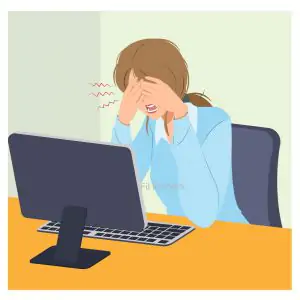Table of Contents
Digital eye strain can be an issue for anyone who frequently uses screens. These screens include your computer, tablet, smartphone, laptop, or even e-reader. Although digital eye strain can be uncomfortable, it is easy to resolve and prevent. Read on to find out how to reduce your risk of eye strain.

WHAT IS DIGITAL EYE STRAIN?
Digital eye strain is a symptom of prolonged and intense eye use. It may be brought on by excessive screen use, working in a poorly lit environment, or exposure to extreme brightness or glare. Difficulty focusing, blurred vision, headache, eye fatigue, double vision, and dry eyes are all typical signs of digital eye strain.
WHAT IS BLUE LIGHT?
Blue light is a color in the visible light spectrum that can be seen by human eyes. Sources of blue light include the sun, digital screens, electronic devices, and fluorescent and LED lighting. Digital devices emit significant amounts of blue light. Blue light has been associated with digital eye strain and disruption of normal sleep cycles.
20-20-20 RULE
Taking breaks from your screen is the first thing to implement. Eye breaks need to become part of your routine. For every 20 minutes of screen exposure, pause and stare at an object 20 feet away for 20 seconds.
Alongside these micro eye-breaks, take longer breaks from your screen. Move around every 30-45 minutes, this is important for your body and your eyes.
CHECK YOUR SCREEN BRIGHTNESS AND FONT SIZE
Use your device to your advantage, most computers, smartphones, and tablets will allow you to adjust the display settings.
Keep your screen at the same brightness as your work environment. If you are working in a room with a natural light source, place your screen at a 90-degree angle from the light source where possible. Screens that are too dark or too bright can create a glare on your screen that may strain your eyes. Check for glare before switching your screen on.
Another way to reduce digital eye strain is to increase the font size on your screen. Making the text larger can make it easier to read. This will also mean that you do not find yourself having to come closer to the screen to read.
COMPUTER GLASSES FOR DIGITAL EYE STRAIN
Computer glasses with yellow-tinted lenses may increase comfort when you’re viewing digital devices for extended periods of time. These will block out some of the blue light. You can buy blue light glasses with or without a prescription.
EYE TESTS
Regular screen users need to have their eyes tested yearly. If you do have symptoms of digital eyestrain as described above, discuss with your healthcare provider and request an eye test.
ERGONOMICS SUPPORT FOR YOUR COMPANY
Fit For Work provide a range of ergonomics services which are suitable for those working from home/remotely or those who are office-based. To learn more about office setup and good ergonomics principles, you can reach out to Fit for Work at info@fitforworksg.com to talk about how an ergonomic programme within your office can increase productivity, increase staff satisfaction, improve staff retention and reduce sick leave.
This article does not constitute legal advice.
The opinions expressed in the column above represent the author’s own.
Start managing your legal needs with Zegal today
BECOME A ZEGAL REFERRAL PARTNER
READ MORE:5 Tips to stay sane and healthy when working from home
FURTHER READING: Are you sitting at your desk correctly?
Article syndicated with permission from https://www.fitforworksg.com/digital-eye-strain-how-to-prevent-it/
Fitforwork is a business in Singapore that focuses on the comfort of its clients. They use two most commonly used phrases; “Prevention is key and ‘” One size DOES NOT fit all. They believe that we are all different shapes and sizes, we have different work roles and demands, no two personal and professional situations are the same, therefore every workstation setup is unique to the individual and we must fit the work to the worker.
Their objective is to understand physical capabilities and work demands to reduce risk within the workplace, increase productivity and overall comfort and worker satisfaction. Their mission is to tell as many people as possible that the commonly felt neck pain, shoulder pain, back pain frequently experienced by office workers is not normal and that very some small changes can have a huge impact in reducing or eliminating these pains entirely.




